Report on Learning Needs of a Disabled Student at University
VerifiedAdded on 2020/05/28
|17
|3479
|190
Report
AI Summary
This report focuses on the educational needs of a deaf student, highlighting the importance of inclusive learning environments and tailored pedagogical approaches within the Australian education system. It identifies the student's strengths, such as sequential memory and visuospatial recall, while also addressing the challenges faced by deaf students, including communication barriers and access to appropriate learning materials. The report outlines inclusive learning goals, expectations, and a comprehensive plan to support the student's learning, including strategies like clear communication, visual aids, and classroom modifications. It emphasizes the need for special curriculum materials, language development classes, and appropriate communication techniques. The report also discusses the role of teachers in fostering communication skills and providing a supportive learning environment. Furthermore, it offers insights into the importance of specialized services both inside and outside the classroom to cater to the unique needs of the deaf student. The report is a valuable resource for educators and anyone interested in inclusive education practices.
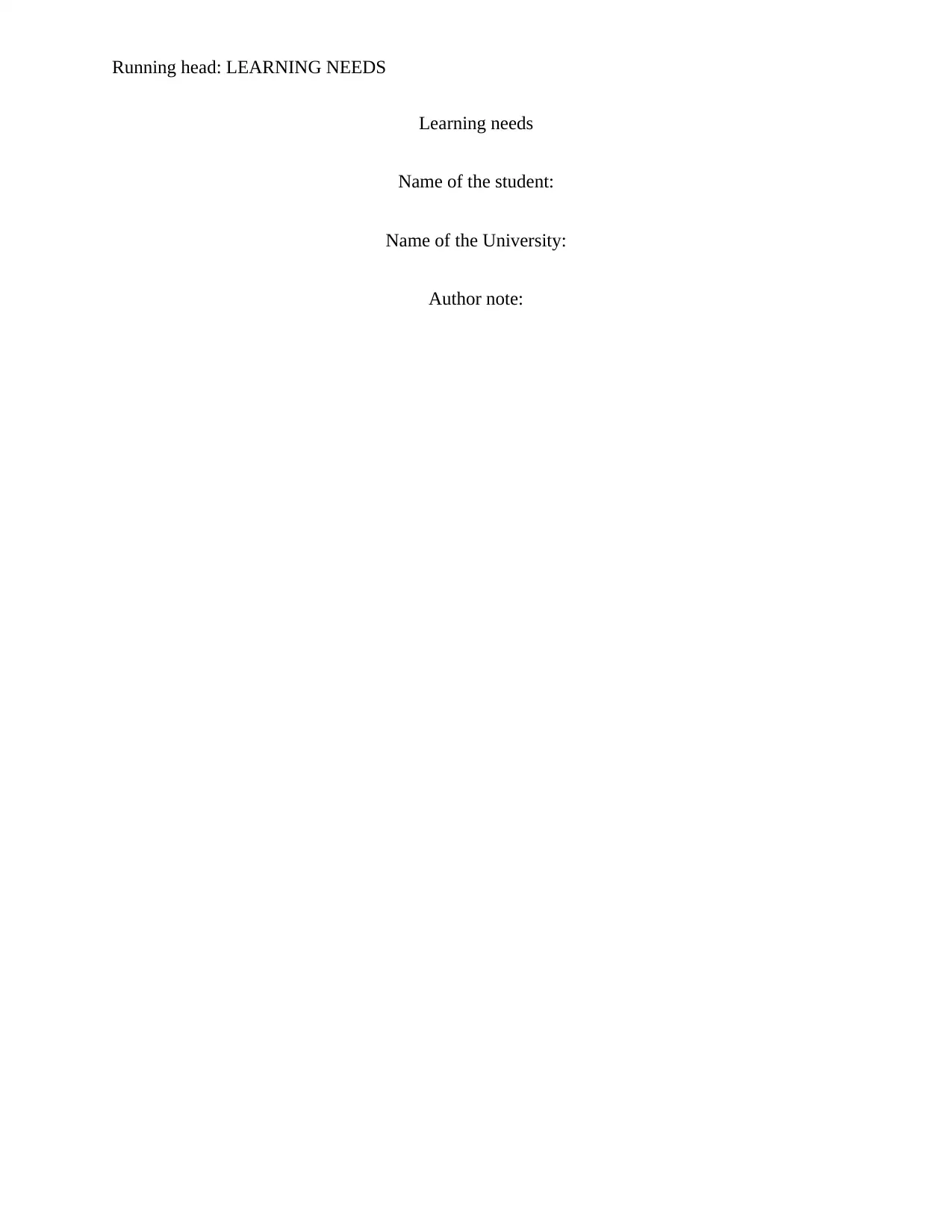
Running head: LEARNING NEEDS
Learning needs
Name of the student:
Name of the University:
Author note:
Learning needs
Name of the student:
Name of the University:
Author note:
Paraphrase This Document
Need a fresh take? Get an instant paraphrase of this document with our AI Paraphraser
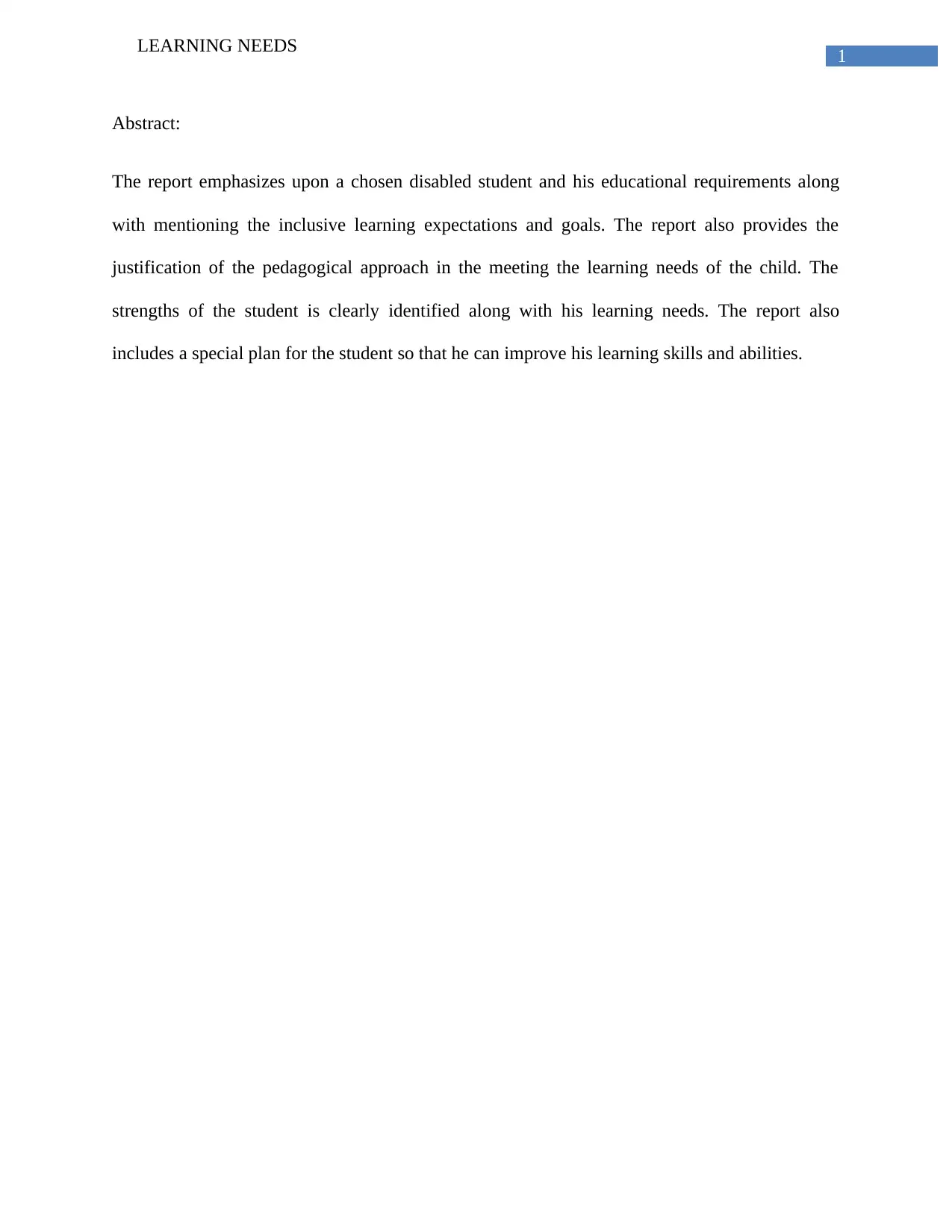
1
LEARNING NEEDS
Abstract:
The report emphasizes upon a chosen disabled student and his educational requirements along
with mentioning the inclusive learning expectations and goals. The report also provides the
justification of the pedagogical approach in the meeting the learning needs of the child. The
strengths of the student is clearly identified along with his learning needs. The report also
includes a special plan for the student so that he can improve his learning skills and abilities.
LEARNING NEEDS
Abstract:
The report emphasizes upon a chosen disabled student and his educational requirements along
with mentioning the inclusive learning expectations and goals. The report also provides the
justification of the pedagogical approach in the meeting the learning needs of the child. The
strengths of the student is clearly identified along with his learning needs. The report also
includes a special plan for the student so that he can improve his learning skills and abilities.
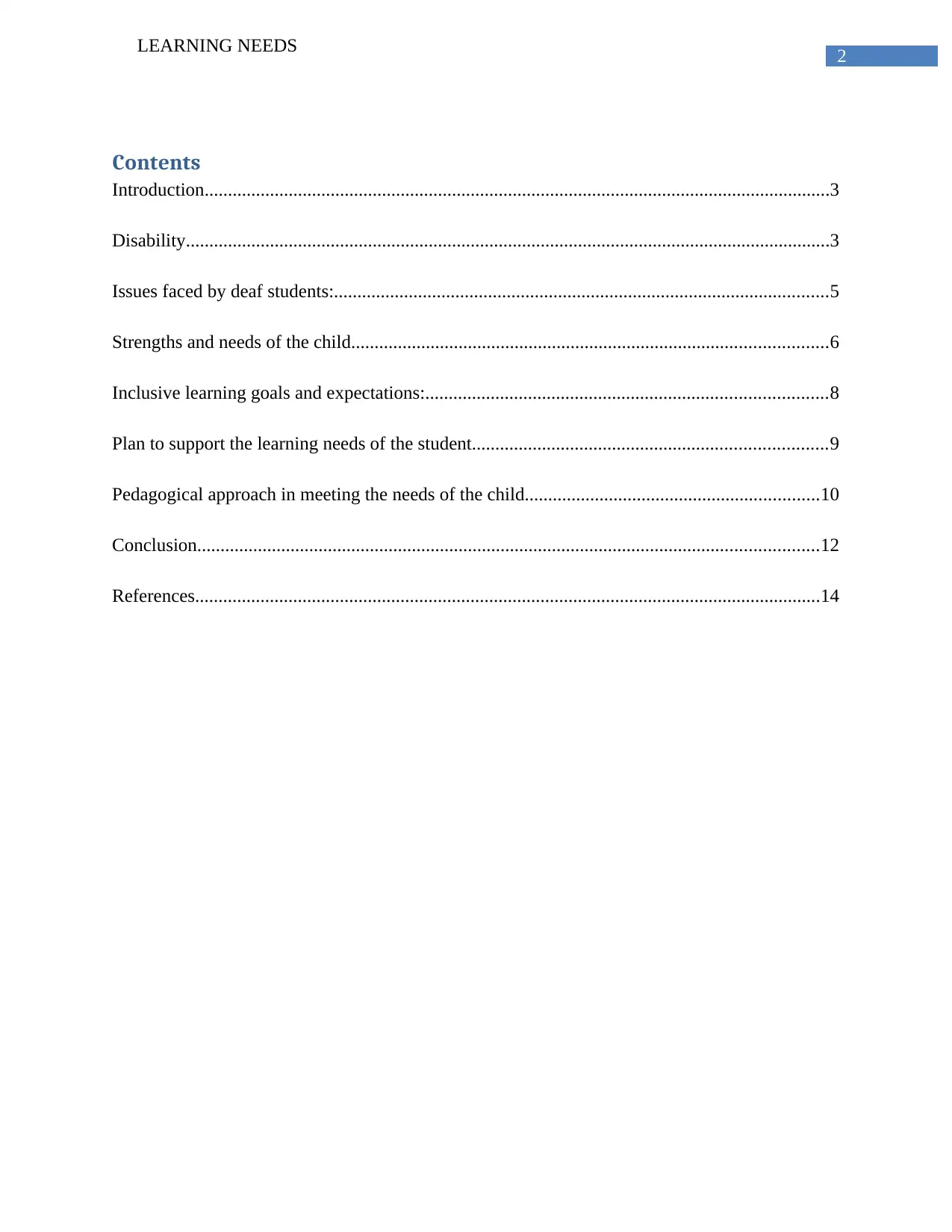
2
LEARNING NEEDS
Contents
Introduction......................................................................................................................................3
Disability..........................................................................................................................................3
Issues faced by deaf students:..........................................................................................................5
Strengths and needs of the child......................................................................................................6
Inclusive learning goals and expectations:......................................................................................8
Plan to support the learning needs of the student............................................................................9
Pedagogical approach in meeting the needs of the child...............................................................10
Conclusion.....................................................................................................................................12
References......................................................................................................................................14
LEARNING NEEDS
Contents
Introduction......................................................................................................................................3
Disability..........................................................................................................................................3
Issues faced by deaf students:..........................................................................................................5
Strengths and needs of the child......................................................................................................6
Inclusive learning goals and expectations:......................................................................................8
Plan to support the learning needs of the student............................................................................9
Pedagogical approach in meeting the needs of the child...............................................................10
Conclusion.....................................................................................................................................12
References......................................................................................................................................14
⊘ This is a preview!⊘
Do you want full access?
Subscribe today to unlock all pages.

Trusted by 1+ million students worldwide
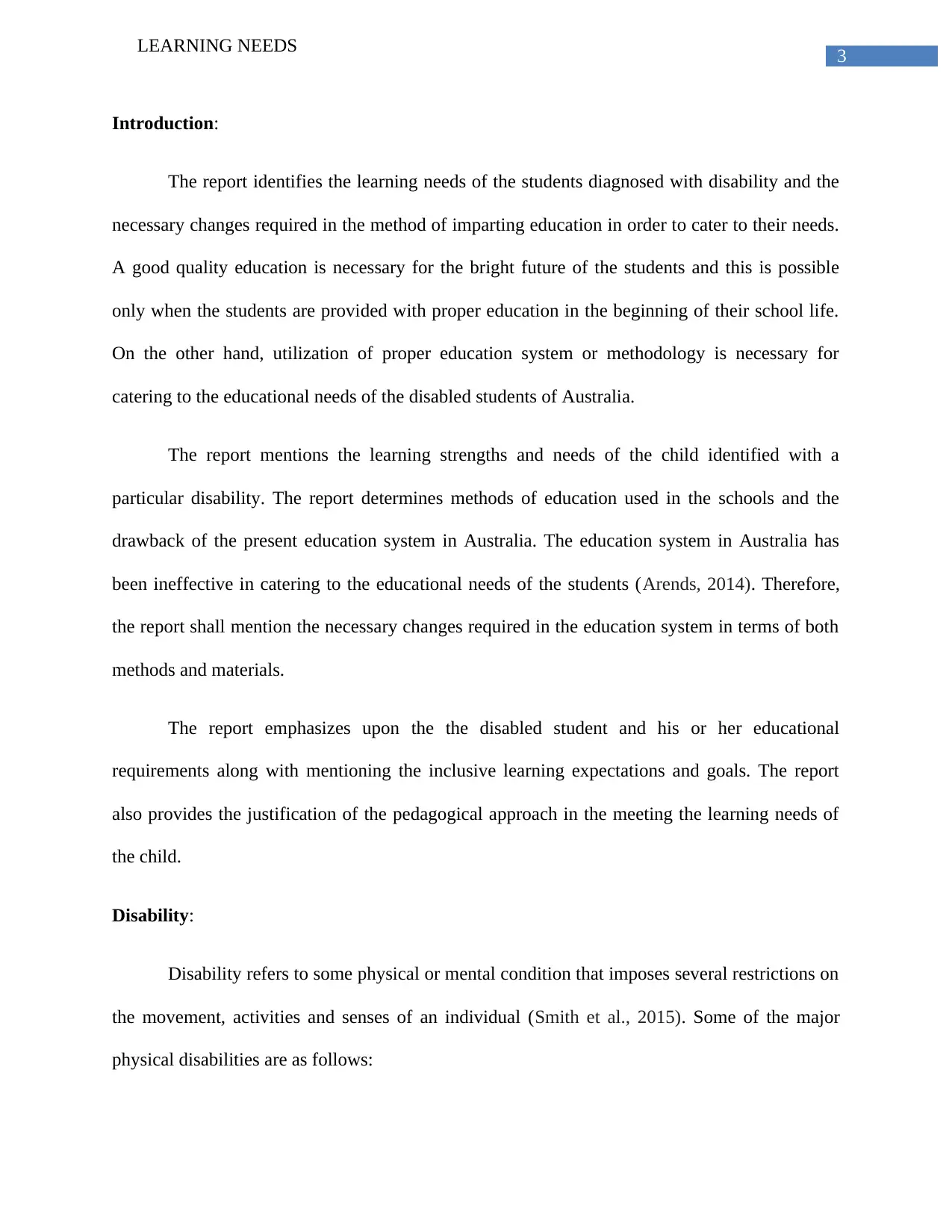
3
LEARNING NEEDS
Introduction:
The report identifies the learning needs of the students diagnosed with disability and the
necessary changes required in the method of imparting education in order to cater to their needs.
A good quality education is necessary for the bright future of the students and this is possible
only when the students are provided with proper education in the beginning of their school life.
On the other hand, utilization of proper education system or methodology is necessary for
catering to the educational needs of the disabled students of Australia.
The report mentions the learning strengths and needs of the child identified with a
particular disability. The report determines methods of education used in the schools and the
drawback of the present education system in Australia. The education system in Australia has
been ineffective in catering to the educational needs of the students (Arends, 2014). Therefore,
the report shall mention the necessary changes required in the education system in terms of both
methods and materials.
The report emphasizes upon the the disabled student and his or her educational
requirements along with mentioning the inclusive learning expectations and goals. The report
also provides the justification of the pedagogical approach in the meeting the learning needs of
the child.
Disability:
Disability refers to some physical or mental condition that imposes several restrictions on
the movement, activities and senses of an individual (Smith et al., 2015). Some of the major
physical disabilities are as follows:
LEARNING NEEDS
Introduction:
The report identifies the learning needs of the students diagnosed with disability and the
necessary changes required in the method of imparting education in order to cater to their needs.
A good quality education is necessary for the bright future of the students and this is possible
only when the students are provided with proper education in the beginning of their school life.
On the other hand, utilization of proper education system or methodology is necessary for
catering to the educational needs of the disabled students of Australia.
The report mentions the learning strengths and needs of the child identified with a
particular disability. The report determines methods of education used in the schools and the
drawback of the present education system in Australia. The education system in Australia has
been ineffective in catering to the educational needs of the students (Arends, 2014). Therefore,
the report shall mention the necessary changes required in the education system in terms of both
methods and materials.
The report emphasizes upon the the disabled student and his or her educational
requirements along with mentioning the inclusive learning expectations and goals. The report
also provides the justification of the pedagogical approach in the meeting the learning needs of
the child.
Disability:
Disability refers to some physical or mental condition that imposes several restrictions on
the movement, activities and senses of an individual (Smith et al., 2015). Some of the major
physical disabilities are as follows:
Paraphrase This Document
Need a fresh take? Get an instant paraphrase of this document with our AI Paraphraser
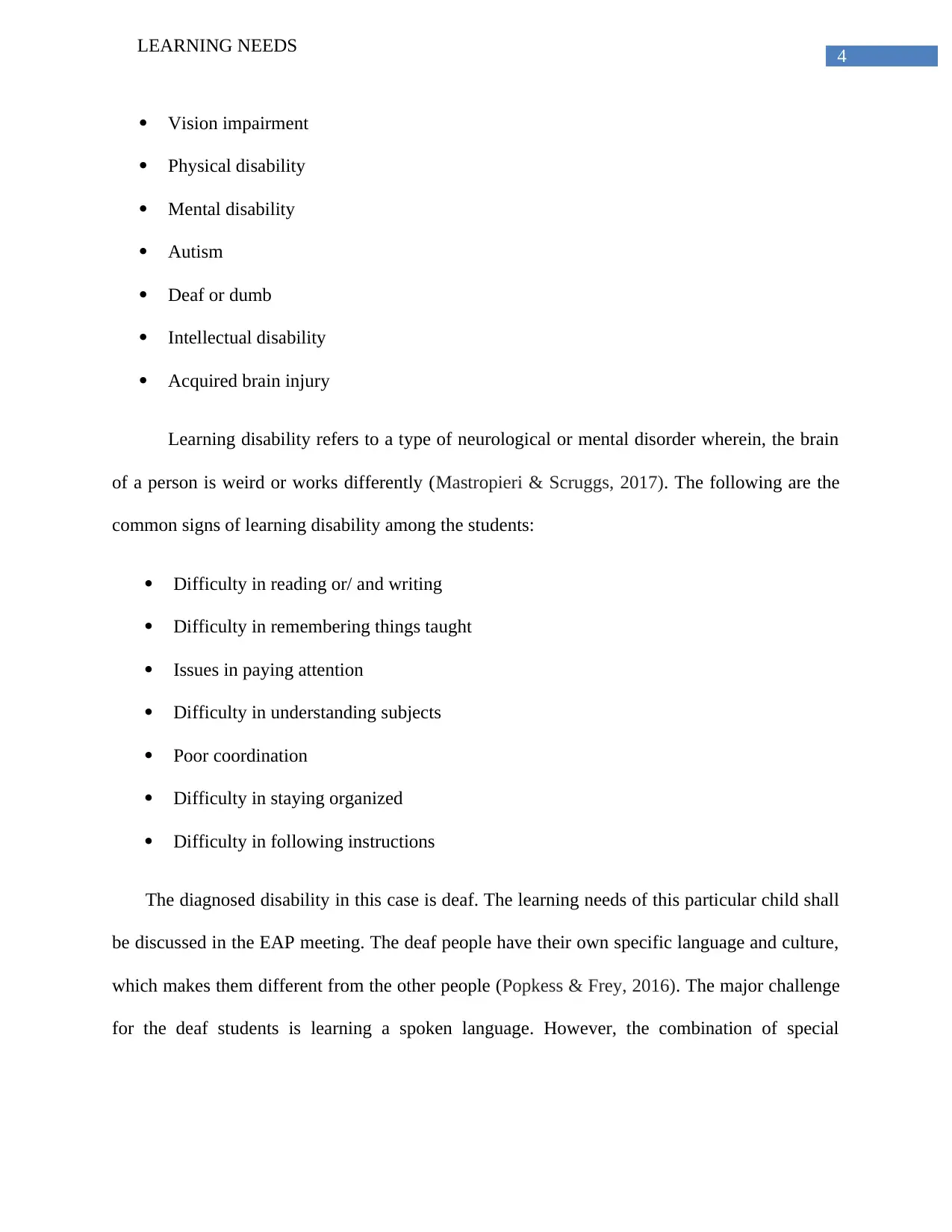
4
LEARNING NEEDS
Vision impairment
Physical disability
Mental disability
Autism
Deaf or dumb
Intellectual disability
Acquired brain injury
Learning disability refers to a type of neurological or mental disorder wherein, the brain
of a person is weird or works differently (Mastropieri & Scruggs, 2017). The following are the
common signs of learning disability among the students:
Difficulty in reading or/ and writing
Difficulty in remembering things taught
Issues in paying attention
Difficulty in understanding subjects
Poor coordination
Difficulty in staying organized
Difficulty in following instructions
The diagnosed disability in this case is deaf. The learning needs of this particular child shall
be discussed in the EAP meeting. The deaf people have their own specific language and culture,
which makes them different from the other people (Popkess & Frey, 2016). The major challenge
for the deaf students is learning a spoken language. However, the combination of special
LEARNING NEEDS
Vision impairment
Physical disability
Mental disability
Autism
Deaf or dumb
Intellectual disability
Acquired brain injury
Learning disability refers to a type of neurological or mental disorder wherein, the brain
of a person is weird or works differently (Mastropieri & Scruggs, 2017). The following are the
common signs of learning disability among the students:
Difficulty in reading or/ and writing
Difficulty in remembering things taught
Issues in paying attention
Difficulty in understanding subjects
Poor coordination
Difficulty in staying organized
Difficulty in following instructions
The diagnosed disability in this case is deaf. The learning needs of this particular child shall
be discussed in the EAP meeting. The deaf people have their own specific language and culture,
which makes them different from the other people (Popkess & Frey, 2016). The major challenge
for the deaf students is learning a spoken language. However, the combination of special
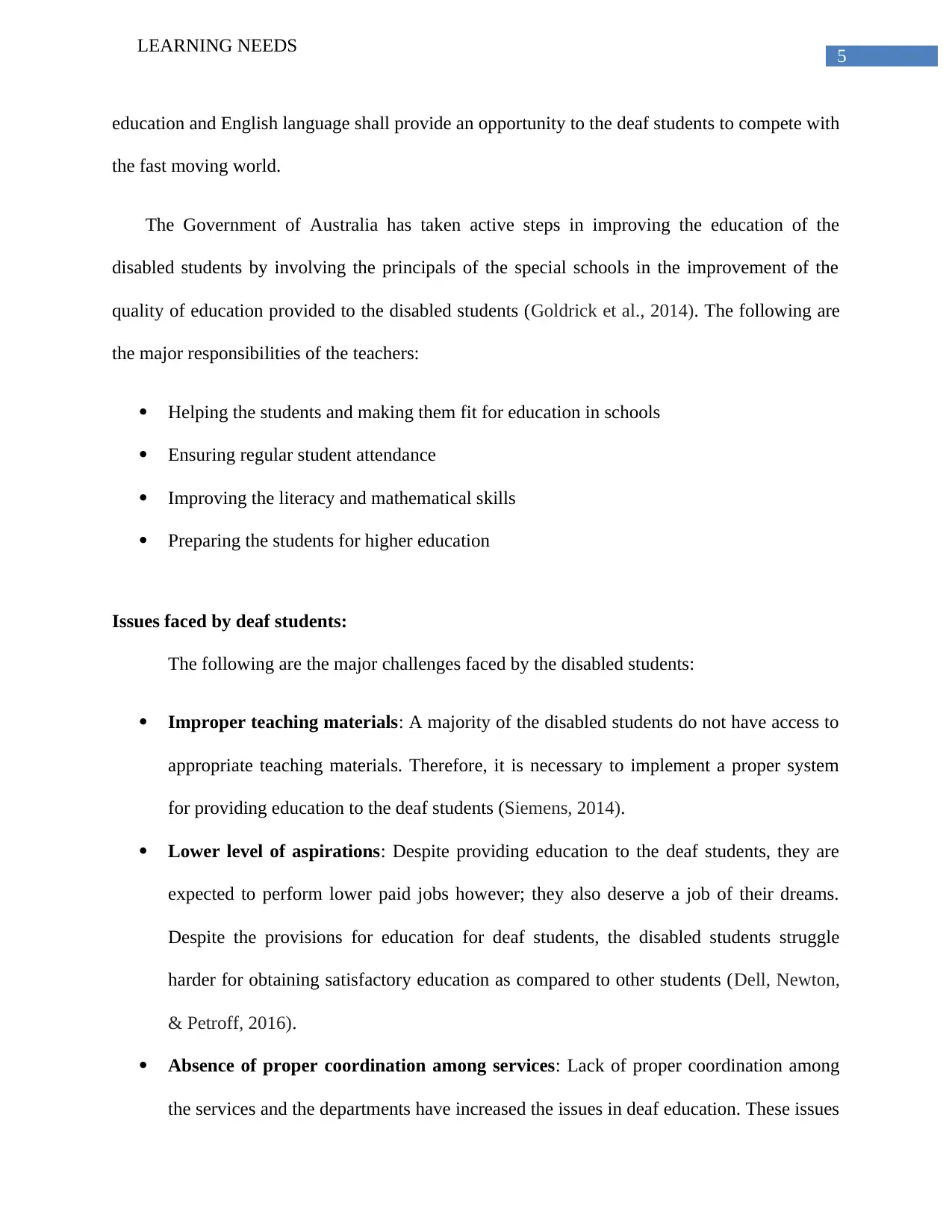
5
LEARNING NEEDS
education and English language shall provide an opportunity to the deaf students to compete with
the fast moving world.
The Government of Australia has taken active steps in improving the education of the
disabled students by involving the principals of the special schools in the improvement of the
quality of education provided to the disabled students (Goldrick et al., 2014). The following are
the major responsibilities of the teachers:
Helping the students and making them fit for education in schools
Ensuring regular student attendance
Improving the literacy and mathematical skills
Preparing the students for higher education
Issues faced by deaf students:
The following are the major challenges faced by the disabled students:
Improper teaching materials: A majority of the disabled students do not have access to
appropriate teaching materials. Therefore, it is necessary to implement a proper system
for providing education to the deaf students (Siemens, 2014).
Lower level of aspirations: Despite providing education to the deaf students, they are
expected to perform lower paid jobs however; they also deserve a job of their dreams.
Despite the provisions for education for deaf students, the disabled students struggle
harder for obtaining satisfactory education as compared to other students (Dell, Newton,
& Petroff, 2016).
Absence of proper coordination among services: Lack of proper coordination among
the services and the departments have increased the issues in deaf education. These issues
LEARNING NEEDS
education and English language shall provide an opportunity to the deaf students to compete with
the fast moving world.
The Government of Australia has taken active steps in improving the education of the
disabled students by involving the principals of the special schools in the improvement of the
quality of education provided to the disabled students (Goldrick et al., 2014). The following are
the major responsibilities of the teachers:
Helping the students and making them fit for education in schools
Ensuring regular student attendance
Improving the literacy and mathematical skills
Preparing the students for higher education
Issues faced by deaf students:
The following are the major challenges faced by the disabled students:
Improper teaching materials: A majority of the disabled students do not have access to
appropriate teaching materials. Therefore, it is necessary to implement a proper system
for providing education to the deaf students (Siemens, 2014).
Lower level of aspirations: Despite providing education to the deaf students, they are
expected to perform lower paid jobs however; they also deserve a job of their dreams.
Despite the provisions for education for deaf students, the disabled students struggle
harder for obtaining satisfactory education as compared to other students (Dell, Newton,
& Petroff, 2016).
Absence of proper coordination among services: Lack of proper coordination among
the services and the departments have increased the issues in deaf education. These issues
⊘ This is a preview!⊘
Do you want full access?
Subscribe today to unlock all pages.

Trusted by 1+ million students worldwide
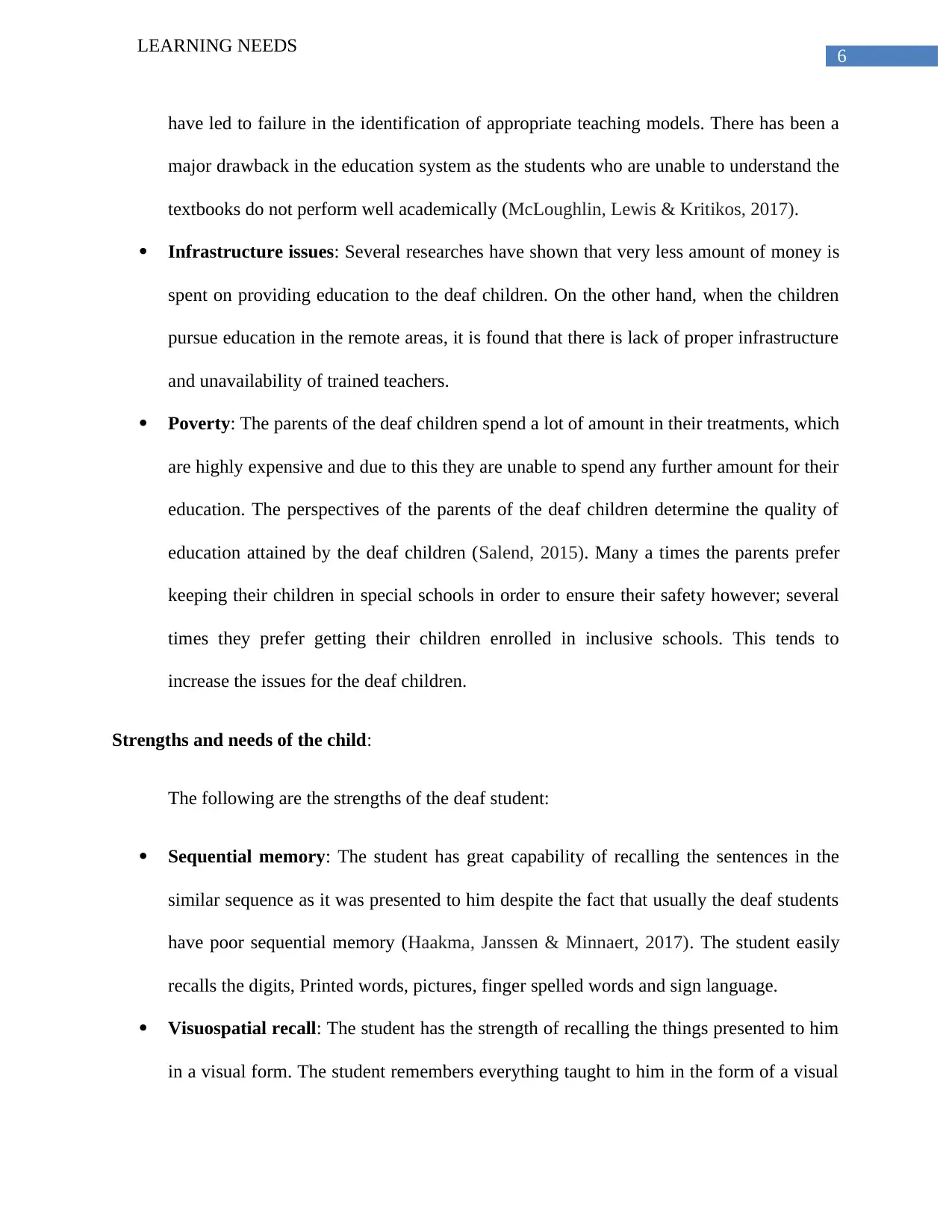
6
LEARNING NEEDS
have led to failure in the identification of appropriate teaching models. There has been a
major drawback in the education system as the students who are unable to understand the
textbooks do not perform well academically (McLoughlin, Lewis & Kritikos, 2017).
Infrastructure issues: Several researches have shown that very less amount of money is
spent on providing education to the deaf children. On the other hand, when the children
pursue education in the remote areas, it is found that there is lack of proper infrastructure
and unavailability of trained teachers.
Poverty: The parents of the deaf children spend a lot of amount in their treatments, which
are highly expensive and due to this they are unable to spend any further amount for their
education. The perspectives of the parents of the deaf children determine the quality of
education attained by the deaf children (Salend, 2015). Many a times the parents prefer
keeping their children in special schools in order to ensure their safety however; several
times they prefer getting their children enrolled in inclusive schools. This tends to
increase the issues for the deaf children.
Strengths and needs of the child:
The following are the strengths of the deaf student:
Sequential memory: The student has great capability of recalling the sentences in the
similar sequence as it was presented to him despite the fact that usually the deaf students
have poor sequential memory (Haakma, Janssen & Minnaert, 2017). The student easily
recalls the digits, Printed words, pictures, finger spelled words and sign language.
Visuospatial recall: The student has the strength of recalling the things presented to him
in a visual form. The student remembers everything taught to him in the form of a visual
LEARNING NEEDS
have led to failure in the identification of appropriate teaching models. There has been a
major drawback in the education system as the students who are unable to understand the
textbooks do not perform well academically (McLoughlin, Lewis & Kritikos, 2017).
Infrastructure issues: Several researches have shown that very less amount of money is
spent on providing education to the deaf children. On the other hand, when the children
pursue education in the remote areas, it is found that there is lack of proper infrastructure
and unavailability of trained teachers.
Poverty: The parents of the deaf children spend a lot of amount in their treatments, which
are highly expensive and due to this they are unable to spend any further amount for their
education. The perspectives of the parents of the deaf children determine the quality of
education attained by the deaf children (Salend, 2015). Many a times the parents prefer
keeping their children in special schools in order to ensure their safety however; several
times they prefer getting their children enrolled in inclusive schools. This tends to
increase the issues for the deaf children.
Strengths and needs of the child:
The following are the strengths of the deaf student:
Sequential memory: The student has great capability of recalling the sentences in the
similar sequence as it was presented to him despite the fact that usually the deaf students
have poor sequential memory (Haakma, Janssen & Minnaert, 2017). The student easily
recalls the digits, Printed words, pictures, finger spelled words and sign language.
Visuospatial recall: The student has the strength of recalling the things presented to him
in a visual form. The student remembers everything taught to him in the form of a visual
Paraphrase This Document
Need a fresh take? Get an instant paraphrase of this document with our AI Paraphraser
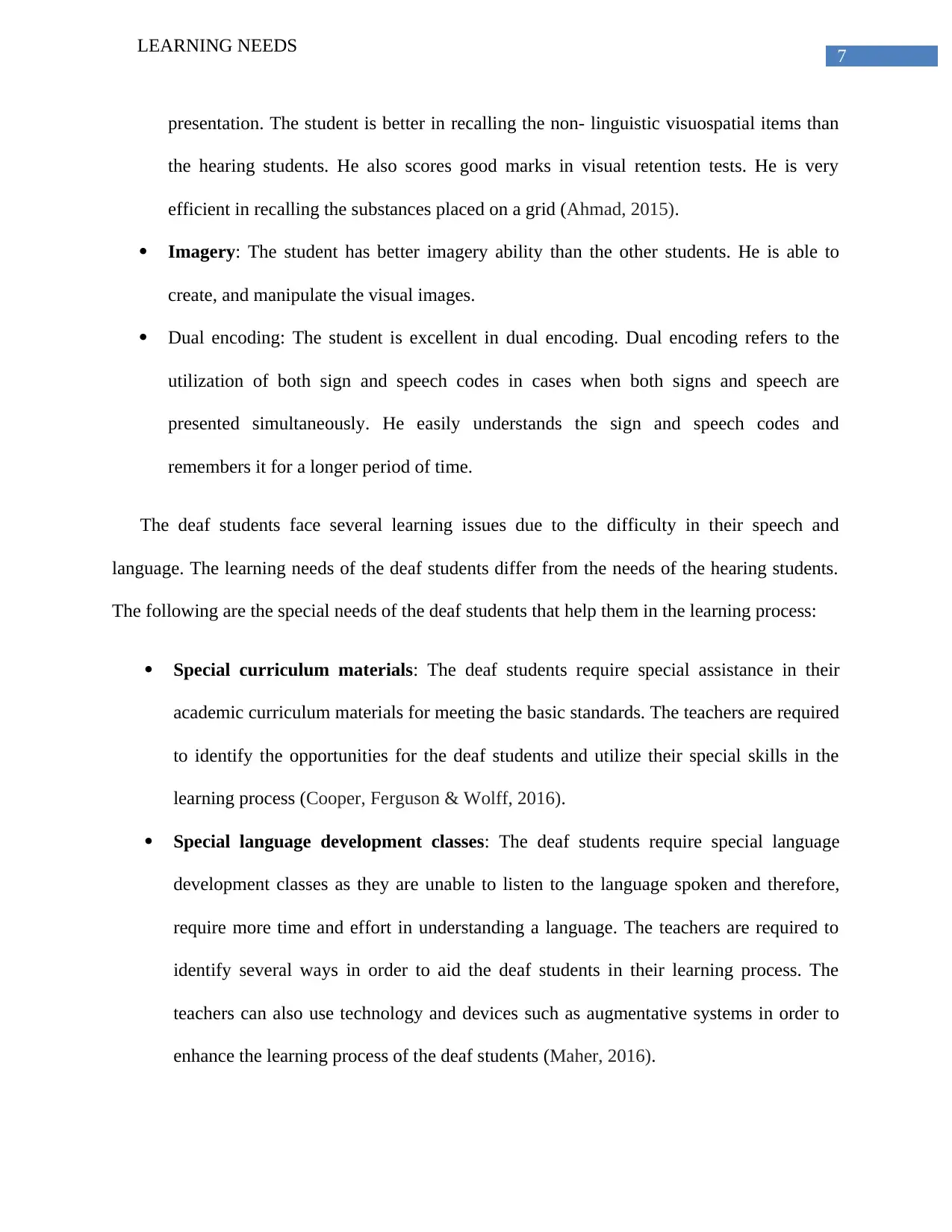
7
LEARNING NEEDS
presentation. The student is better in recalling the non- linguistic visuospatial items than
the hearing students. He also scores good marks in visual retention tests. He is very
efficient in recalling the substances placed on a grid (Ahmad, 2015).
Imagery: The student has better imagery ability than the other students. He is able to
create, and manipulate the visual images.
Dual encoding: The student is excellent in dual encoding. Dual encoding refers to the
utilization of both sign and speech codes in cases when both signs and speech are
presented simultaneously. He easily understands the sign and speech codes and
remembers it for a longer period of time.
The deaf students face several learning issues due to the difficulty in their speech and
language. The learning needs of the deaf students differ from the needs of the hearing students.
The following are the special needs of the deaf students that help them in the learning process:
Special curriculum materials: The deaf students require special assistance in their
academic curriculum materials for meeting the basic standards. The teachers are required
to identify the opportunities for the deaf students and utilize their special skills in the
learning process (Cooper, Ferguson & Wolff, 2016).
Special language development classes: The deaf students require special language
development classes as they are unable to listen to the language spoken and therefore,
require more time and effort in understanding a language. The teachers are required to
identify several ways in order to aid the deaf students in their learning process. The
teachers can also use technology and devices such as augmentative systems in order to
enhance the learning process of the deaf students (Maher, 2016).
LEARNING NEEDS
presentation. The student is better in recalling the non- linguistic visuospatial items than
the hearing students. He also scores good marks in visual retention tests. He is very
efficient in recalling the substances placed on a grid (Ahmad, 2015).
Imagery: The student has better imagery ability than the other students. He is able to
create, and manipulate the visual images.
Dual encoding: The student is excellent in dual encoding. Dual encoding refers to the
utilization of both sign and speech codes in cases when both signs and speech are
presented simultaneously. He easily understands the sign and speech codes and
remembers it for a longer period of time.
The deaf students face several learning issues due to the difficulty in their speech and
language. The learning needs of the deaf students differ from the needs of the hearing students.
The following are the special needs of the deaf students that help them in the learning process:
Special curriculum materials: The deaf students require special assistance in their
academic curriculum materials for meeting the basic standards. The teachers are required
to identify the opportunities for the deaf students and utilize their special skills in the
learning process (Cooper, Ferguson & Wolff, 2016).
Special language development classes: The deaf students require special language
development classes as they are unable to listen to the language spoken and therefore,
require more time and effort in understanding a language. The teachers are required to
identify several ways in order to aid the deaf students in their learning process. The
teachers can also use technology and devices such as augmentative systems in order to
enhance the learning process of the deaf students (Maher, 2016).
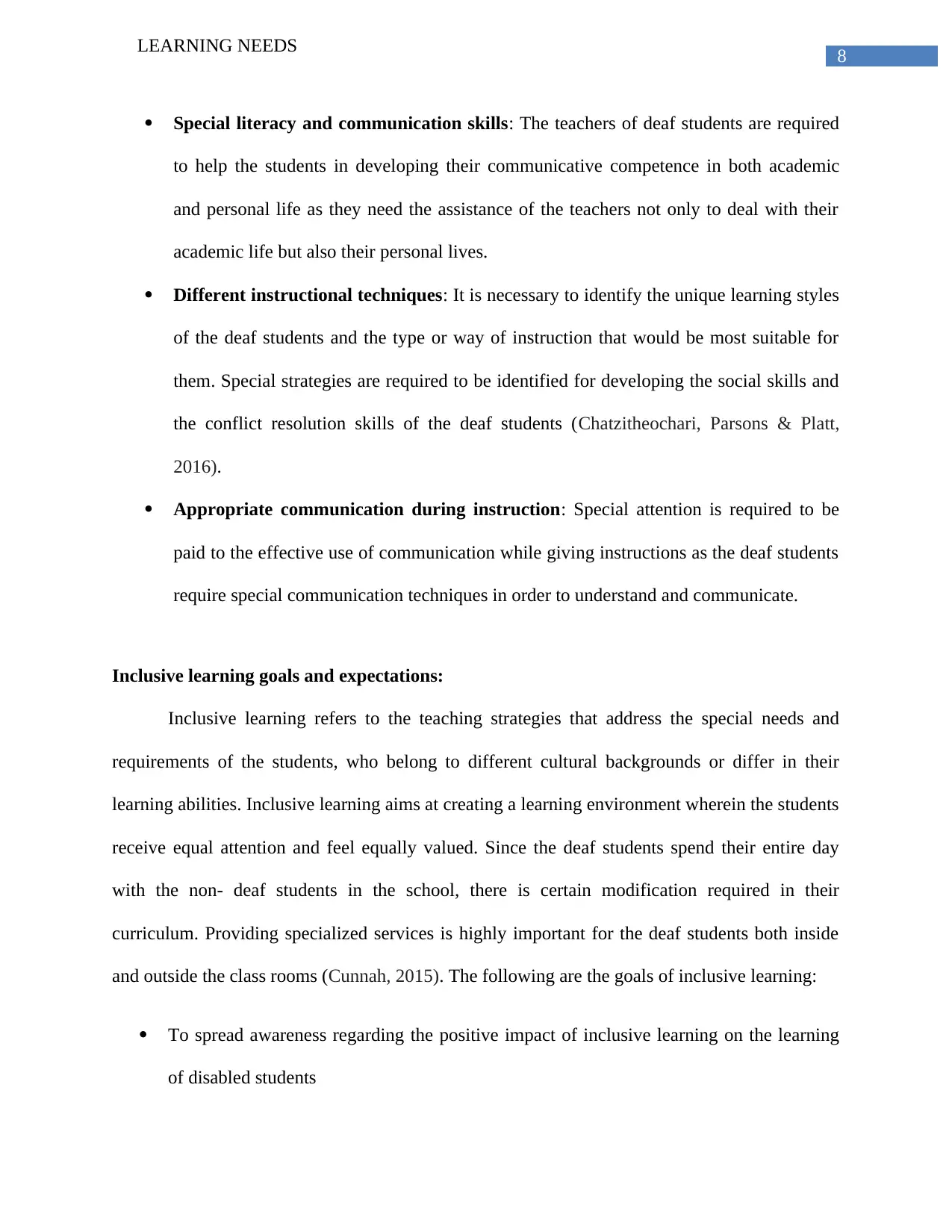
8
LEARNING NEEDS
Special literacy and communication skills: The teachers of deaf students are required
to help the students in developing their communicative competence in both academic
and personal life as they need the assistance of the teachers not only to deal with their
academic life but also their personal lives.
Different instructional techniques: It is necessary to identify the unique learning styles
of the deaf students and the type or way of instruction that would be most suitable for
them. Special strategies are required to be identified for developing the social skills and
the conflict resolution skills of the deaf students (Chatzitheochari, Parsons & Platt,
2016).
Appropriate communication during instruction: Special attention is required to be
paid to the effective use of communication while giving instructions as the deaf students
require special communication techniques in order to understand and communicate.
Inclusive learning goals and expectations:
Inclusive learning refers to the teaching strategies that address the special needs and
requirements of the students, who belong to different cultural backgrounds or differ in their
learning abilities. Inclusive learning aims at creating a learning environment wherein the students
receive equal attention and feel equally valued. Since the deaf students spend their entire day
with the non- deaf students in the school, there is certain modification required in their
curriculum. Providing specialized services is highly important for the deaf students both inside
and outside the class rooms (Cunnah, 2015). The following are the goals of inclusive learning:
To spread awareness regarding the positive impact of inclusive learning on the learning
of disabled students
LEARNING NEEDS
Special literacy and communication skills: The teachers of deaf students are required
to help the students in developing their communicative competence in both academic
and personal life as they need the assistance of the teachers not only to deal with their
academic life but also their personal lives.
Different instructional techniques: It is necessary to identify the unique learning styles
of the deaf students and the type or way of instruction that would be most suitable for
them. Special strategies are required to be identified for developing the social skills and
the conflict resolution skills of the deaf students (Chatzitheochari, Parsons & Platt,
2016).
Appropriate communication during instruction: Special attention is required to be
paid to the effective use of communication while giving instructions as the deaf students
require special communication techniques in order to understand and communicate.
Inclusive learning goals and expectations:
Inclusive learning refers to the teaching strategies that address the special needs and
requirements of the students, who belong to different cultural backgrounds or differ in their
learning abilities. Inclusive learning aims at creating a learning environment wherein the students
receive equal attention and feel equally valued. Since the deaf students spend their entire day
with the non- deaf students in the school, there is certain modification required in their
curriculum. Providing specialized services is highly important for the deaf students both inside
and outside the class rooms (Cunnah, 2015). The following are the goals of inclusive learning:
To spread awareness regarding the positive impact of inclusive learning on the learning
of disabled students
⊘ This is a preview!⊘
Do you want full access?
Subscribe today to unlock all pages.

Trusted by 1+ million students worldwide
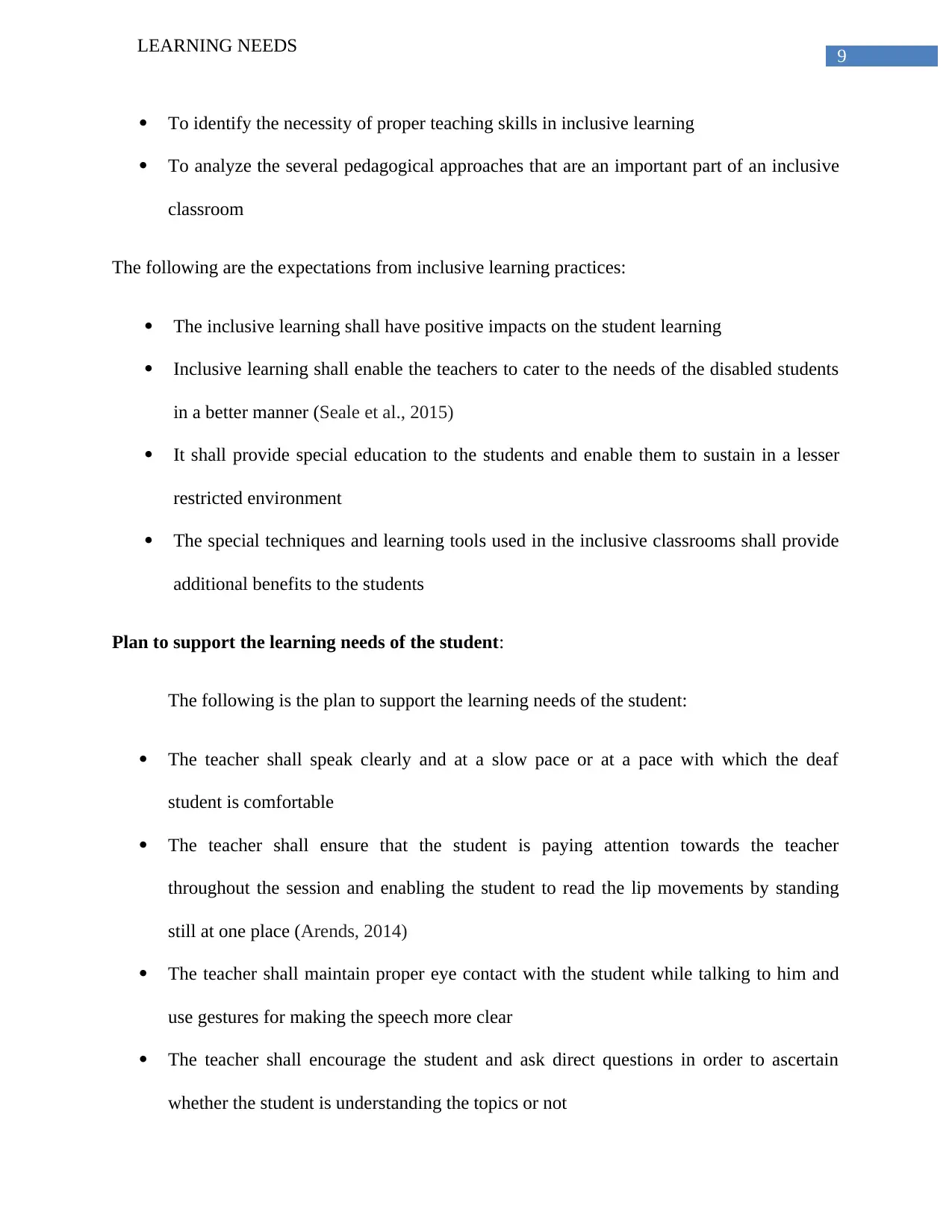
9
LEARNING NEEDS
To identify the necessity of proper teaching skills in inclusive learning
To analyze the several pedagogical approaches that are an important part of an inclusive
classroom
The following are the expectations from inclusive learning practices:
The inclusive learning shall have positive impacts on the student learning
Inclusive learning shall enable the teachers to cater to the needs of the disabled students
in a better manner (Seale et al., 2015)
It shall provide special education to the students and enable them to sustain in a lesser
restricted environment
The special techniques and learning tools used in the inclusive classrooms shall provide
additional benefits to the students
Plan to support the learning needs of the student:
The following is the plan to support the learning needs of the student:
The teacher shall speak clearly and at a slow pace or at a pace with which the deaf
student is comfortable
The teacher shall ensure that the student is paying attention towards the teacher
throughout the session and enabling the student to read the lip movements by standing
still at one place (Arends, 2014)
The teacher shall maintain proper eye contact with the student while talking to him and
use gestures for making the speech more clear
The teacher shall encourage the student and ask direct questions in order to ascertain
whether the student is understanding the topics or not
LEARNING NEEDS
To identify the necessity of proper teaching skills in inclusive learning
To analyze the several pedagogical approaches that are an important part of an inclusive
classroom
The following are the expectations from inclusive learning practices:
The inclusive learning shall have positive impacts on the student learning
Inclusive learning shall enable the teachers to cater to the needs of the disabled students
in a better manner (Seale et al., 2015)
It shall provide special education to the students and enable them to sustain in a lesser
restricted environment
The special techniques and learning tools used in the inclusive classrooms shall provide
additional benefits to the students
Plan to support the learning needs of the student:
The following is the plan to support the learning needs of the student:
The teacher shall speak clearly and at a slow pace or at a pace with which the deaf
student is comfortable
The teacher shall ensure that the student is paying attention towards the teacher
throughout the session and enabling the student to read the lip movements by standing
still at one place (Arends, 2014)
The teacher shall maintain proper eye contact with the student while talking to him and
use gestures for making the speech more clear
The teacher shall encourage the student and ask direct questions in order to ascertain
whether the student is understanding the topics or not
Paraphrase This Document
Need a fresh take? Get an instant paraphrase of this document with our AI Paraphraser
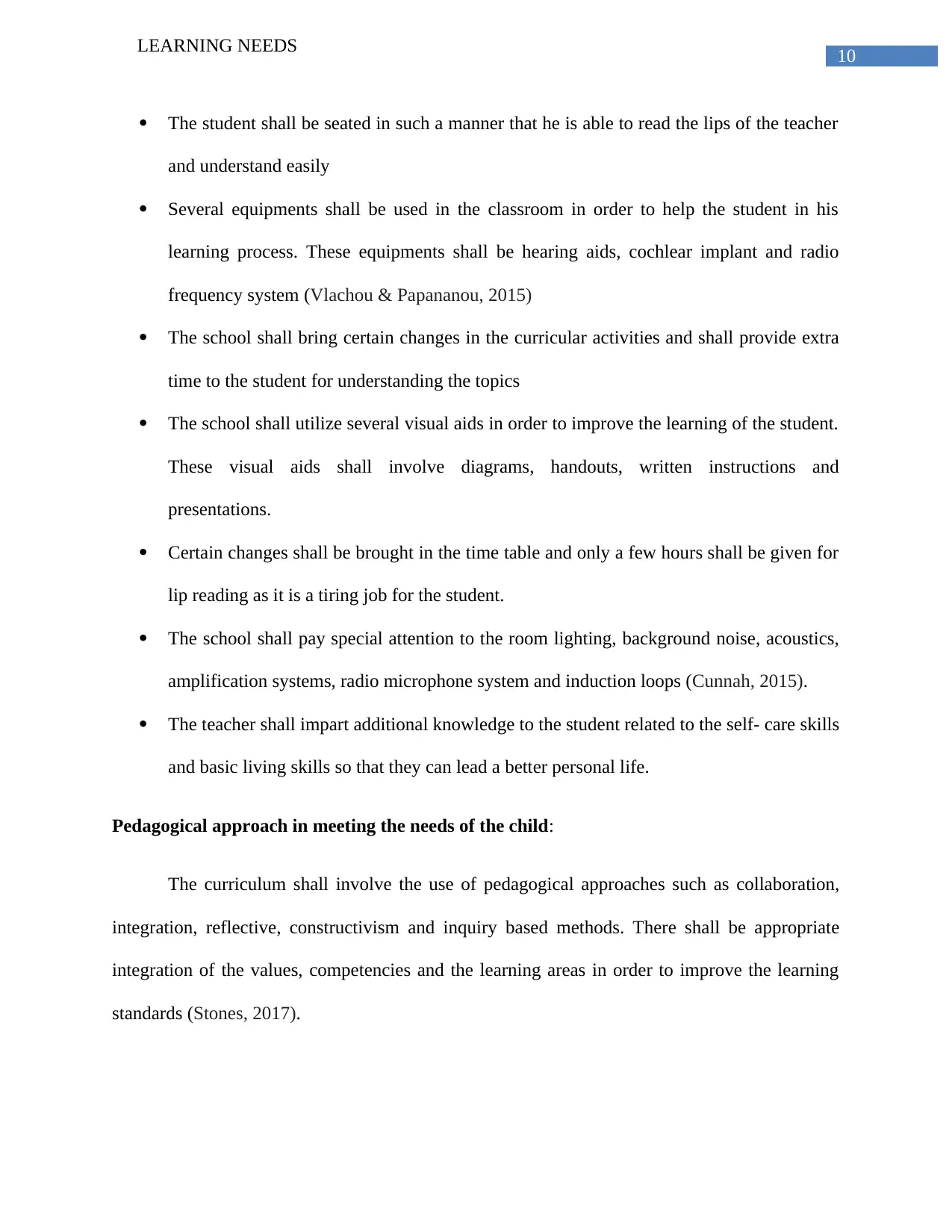
10
LEARNING NEEDS
The student shall be seated in such a manner that he is able to read the lips of the teacher
and understand easily
Several equipments shall be used in the classroom in order to help the student in his
learning process. These equipments shall be hearing aids, cochlear implant and radio
frequency system (Vlachou & Papananou, 2015)
The school shall bring certain changes in the curricular activities and shall provide extra
time to the student for understanding the topics
The school shall utilize several visual aids in order to improve the learning of the student.
These visual aids shall involve diagrams, handouts, written instructions and
presentations.
Certain changes shall be brought in the time table and only a few hours shall be given for
lip reading as it is a tiring job for the student.
The school shall pay special attention to the room lighting, background noise, acoustics,
amplification systems, radio microphone system and induction loops (Cunnah, 2015).
The teacher shall impart additional knowledge to the student related to the self- care skills
and basic living skills so that they can lead a better personal life.
Pedagogical approach in meeting the needs of the child:
The curriculum shall involve the use of pedagogical approaches such as collaboration,
integration, reflective, constructivism and inquiry based methods. There shall be appropriate
integration of the values, competencies and the learning areas in order to improve the learning
standards (Stones, 2017).
LEARNING NEEDS
The student shall be seated in such a manner that he is able to read the lips of the teacher
and understand easily
Several equipments shall be used in the classroom in order to help the student in his
learning process. These equipments shall be hearing aids, cochlear implant and radio
frequency system (Vlachou & Papananou, 2015)
The school shall bring certain changes in the curricular activities and shall provide extra
time to the student for understanding the topics
The school shall utilize several visual aids in order to improve the learning of the student.
These visual aids shall involve diagrams, handouts, written instructions and
presentations.
Certain changes shall be brought in the time table and only a few hours shall be given for
lip reading as it is a tiring job for the student.
The school shall pay special attention to the room lighting, background noise, acoustics,
amplification systems, radio microphone system and induction loops (Cunnah, 2015).
The teacher shall impart additional knowledge to the student related to the self- care skills
and basic living skills so that they can lead a better personal life.
Pedagogical approach in meeting the needs of the child:
The curriculum shall involve the use of pedagogical approaches such as collaboration,
integration, reflective, constructivism and inquiry based methods. There shall be appropriate
integration of the values, competencies and the learning areas in order to improve the learning
standards (Stones, 2017).
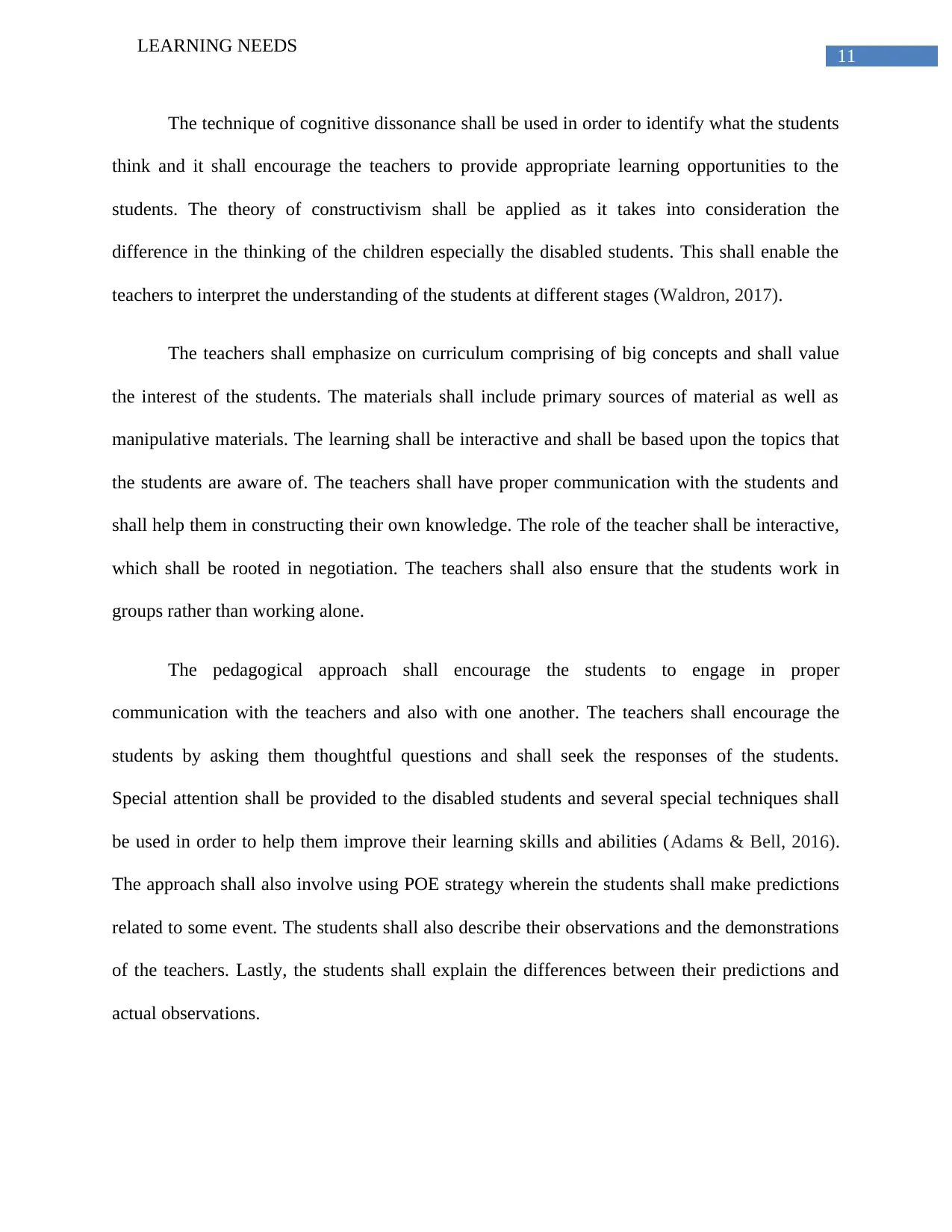
11
LEARNING NEEDS
The technique of cognitive dissonance shall be used in order to identify what the students
think and it shall encourage the teachers to provide appropriate learning opportunities to the
students. The theory of constructivism shall be applied as it takes into consideration the
difference in the thinking of the children especially the disabled students. This shall enable the
teachers to interpret the understanding of the students at different stages (Waldron, 2017).
The teachers shall emphasize on curriculum comprising of big concepts and shall value
the interest of the students. The materials shall include primary sources of material as well as
manipulative materials. The learning shall be interactive and shall be based upon the topics that
the students are aware of. The teachers shall have proper communication with the students and
shall help them in constructing their own knowledge. The role of the teacher shall be interactive,
which shall be rooted in negotiation. The teachers shall also ensure that the students work in
groups rather than working alone.
The pedagogical approach shall encourage the students to engage in proper
communication with the teachers and also with one another. The teachers shall encourage the
students by asking them thoughtful questions and shall seek the responses of the students.
Special attention shall be provided to the disabled students and several special techniques shall
be used in order to help them improve their learning skills and abilities (Adams & Bell, 2016).
The approach shall also involve using POE strategy wherein the students shall make predictions
related to some event. The students shall also describe their observations and the demonstrations
of the teachers. Lastly, the students shall explain the differences between their predictions and
actual observations.
LEARNING NEEDS
The technique of cognitive dissonance shall be used in order to identify what the students
think and it shall encourage the teachers to provide appropriate learning opportunities to the
students. The theory of constructivism shall be applied as it takes into consideration the
difference in the thinking of the children especially the disabled students. This shall enable the
teachers to interpret the understanding of the students at different stages (Waldron, 2017).
The teachers shall emphasize on curriculum comprising of big concepts and shall value
the interest of the students. The materials shall include primary sources of material as well as
manipulative materials. The learning shall be interactive and shall be based upon the topics that
the students are aware of. The teachers shall have proper communication with the students and
shall help them in constructing their own knowledge. The role of the teacher shall be interactive,
which shall be rooted in negotiation. The teachers shall also ensure that the students work in
groups rather than working alone.
The pedagogical approach shall encourage the students to engage in proper
communication with the teachers and also with one another. The teachers shall encourage the
students by asking them thoughtful questions and shall seek the responses of the students.
Special attention shall be provided to the disabled students and several special techniques shall
be used in order to help them improve their learning skills and abilities (Adams & Bell, 2016).
The approach shall also involve using POE strategy wherein the students shall make predictions
related to some event. The students shall also describe their observations and the demonstrations
of the teachers. Lastly, the students shall explain the differences between their predictions and
actual observations.
⊘ This is a preview!⊘
Do you want full access?
Subscribe today to unlock all pages.

Trusted by 1+ million students worldwide
1 out of 17
Related Documents
Your All-in-One AI-Powered Toolkit for Academic Success.
+13062052269
info@desklib.com
Available 24*7 on WhatsApp / Email
![[object Object]](/_next/static/media/star-bottom.7253800d.svg)
Unlock your academic potential
Copyright © 2020–2025 A2Z Services. All Rights Reserved. Developed and managed by ZUCOL.





